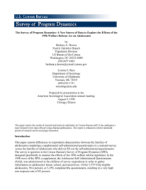
An official website of the United States government
Here’s how you know
Official websites use .gov
A .gov website belongs to an official government organization in the United States.
Secure .gov websites use HTTPS
A lock (
) or https:// means you’ve safely connected to the .gov website. Share sensitive information only on official, secure websites.
-
//
- Census.gov /
- Library /
- Census Working Papers /
- Source of Data to Explore the Effects of the '96 Welfare Reform Act
The Survey of Program Dynamics: A New Source of Data to Explore the Effects of the 1996 Welfare Reform Act on Adolescents
The Survey of Program Dynamics: A New Source of Data to Explore the Effects of the 1996 Welfare Reform Act on Adolescents
Introduction
This paper reports differences in respondent characteristics between the families of adolescents completing a supplemental self-administered questionnaire in a national survey versus the families of adolescents who did not fill out the self-administered questionnaire. The survey in question is the Census Bureau's Survey of Program Dynamics (SPD), designed specifically to monitor the effects of the 1996 welfare reform legislation. In the 1998 wave of the SPD, a supplement, the Adolescent Self-Administered Questionnaire (SAQ), was administered to the children of survey respondents in order to gather information on adolescents' home, school, and social lives. Of the 5,579 SAQ-eligible adolescents, 58.4 percent, or 3,259, completed the questionnaire, resulting in a very high non-response rate of 42 percent.
If completion of the SAQ is related to respondent characteristics, as measured in the CORE section of the SPD, then the next administration of the supplement, in 2001, should receive special attention designed to reduce the likelihood of differential non-response. This paper therefore reports any significant differences among respondents and non-respondents regarding the SAQ. Furthermore, the findings presented here will provide users of SPD data, and in particular, SAQ data, with information which will be of use in interpreting their analysis results. Specifically, these findings will show which variables may be unreliable indicators because they are related to whether the survey was completed or not.
The data collected in the SPD span 10 years; they are a unique source of information with which to study the consequences of changes in public assistance laws and patterns. Losing cases may result in less reliable estimates of the statistics attempted to be measured by the survey. Therefore, high non-response is of great concern in this longitudinal survey. This paper explores what factors may be related to failure to complete the Adolescent SAQ. The results will tell us if child and parent characteristics are related to the low level of response to the SAQ, or if the high non-response is random in nature.
Share
Related Information
Some content on this site is available in several different electronic formats. Some of the files may require a plug-in or additional software to view.
 Yes
Yes
 No
NoComments or suggestions?


Top

